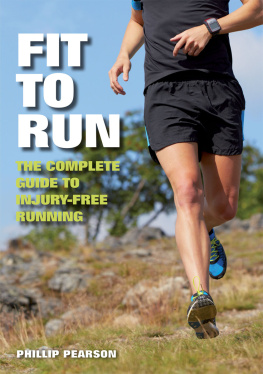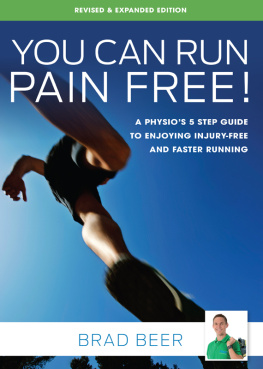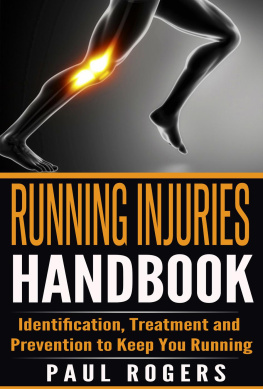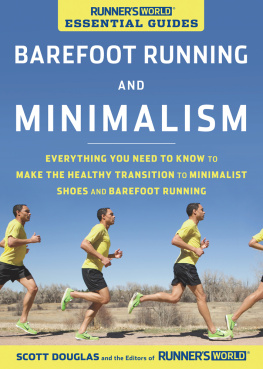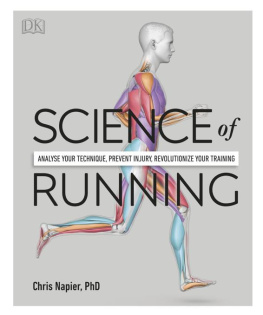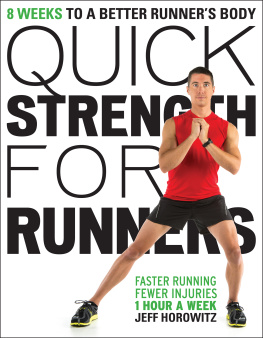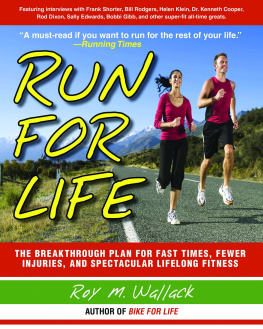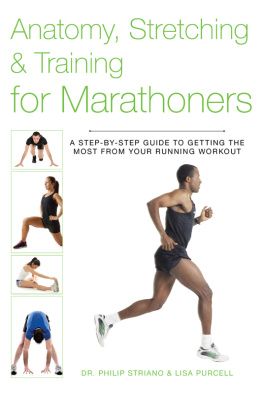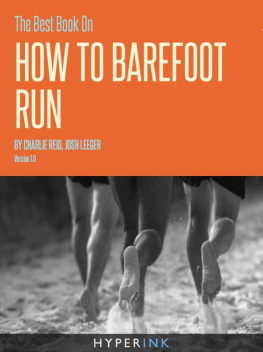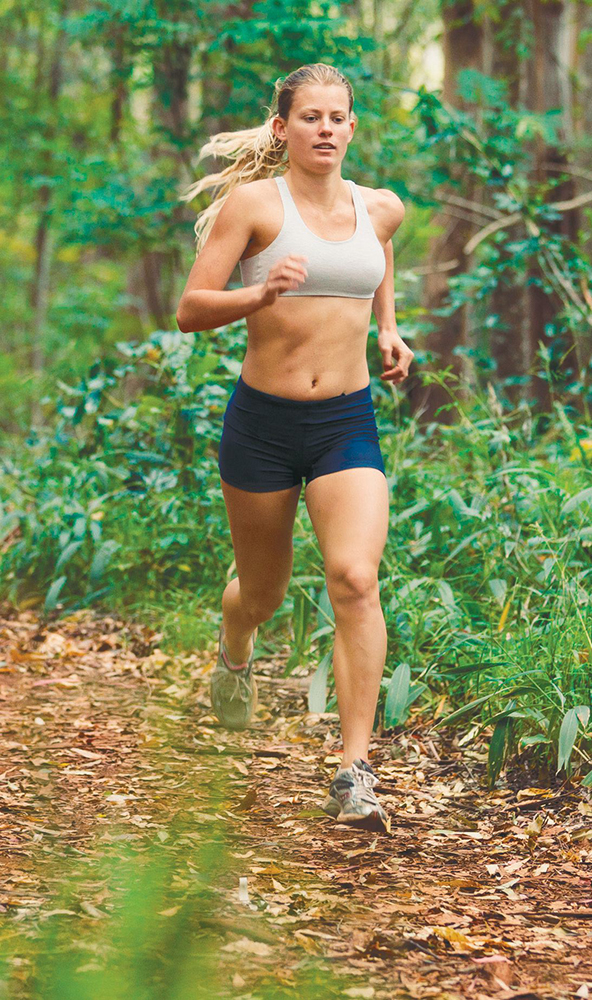Healthy Running
Step by Step
SELF-GUIDED METHODS FOR INJURY-FREE RUNNING:
TRAINING TECHNIQUE NUTRITION REHAB
Robert Forster, P.T.,
and Roy M. Wallack

RF:
To my son Gianni, the best runner I have ever coached.
RMW:
To my son Joey, my dedicated shoe tester, form and diet lab rat, and Tough Mudder teammate.
2014 Fair Winds Press
Text 2014 Robert Forster, P.T., and Roy M. Wallack
Photography 2014 Fair Winds Press
First published in the USA in 2014 by
Fair Winds Press, a member of
Quarto Publishing Group USA Inc.
100 Cummings Center
Suite 406-L
Beverly, MA 01915-6101
www.fairwindspress.com
Visit www.bodymindbeautyhealth.com. Its your personal guide to a happy, healthy, and extraordinary life!
All rights reserved. No part of this book may be reproduced or utilized, in any form or by any means, electronic or mechanical, without prior permission in writing from the publisher.
18 17 16 15 141 2 3 4 5
Digital edition published in 2014
Digital edition: 978-1-62788-021-3
Softcover edition: 978-1-59233-605-0
Library of Congress Cataloging-in-Publication Data available
Book design and layout by Megan Jones Design
All photography by Gregg Segal Photography except pages by John Livzey.
The information in this book is for educational purposes only. It is not intended to replace the advice of a physician or medical practitioner. Please see your health care provider before beginning any new health program.
CONTENTS
SECTION 1:
A Long-Term Guide to Injury Prevention and Peak Performance
SECTION 2:
Runnings Big Five Injuriesand How to Fix Them for Good
Introduction
Nothings sadder than a runner who cant run. At any one time, there are a lot of sad runners. Some studies say that 50 percent of runners every year get injured enough so they cant run, while others say its as much as 80 percent.
I was sad and desperate the day I walked into the Santa Monica, California, office of Forster Physical Therapy, the go-to fix-it shop for West L.A.s runners, cyclists, and adventure racers. It was April 1999, 2 weeks before the Boston Marathon. Id planned to run it, had purchased a plane ticket months before, but had a problem: Id only done a total of 20 miles (32 km) in the previous 4 months because of intense, searing pain in my left hip when I ran. During that time, Id already gone to several physical therapists, who typically had me do a series of pelvic stretching exercises; these did not solve the problem at all.
But Robert Forster, a PT-to-the-stars known for treating some of the biggest names in running, tennis, and other sports, starting with Florence Flo-Jo Griffith Joyner and Jackie Joyner-Kersee at the 1984 and 1988 Olympics, approached my hip pain differently. He didnt mention stretching at all (that would come later). He had me jog up and down the hallway for 10 seconds. Then he said this:
You have excessive side-to-side body sway that is torquing your hip; thats probably whats causing the pain. To stop the sway, try swinging your arms vertically alongside your rib cage, not sideways across your chest. Until that moment, I had no idea that my arms did not swing vertically.
Forster wasnt done yet. As for your crazy fantasy of finishing a marathon on no training, you have no hope whatsoever of doing that unless
Unless what? I said.
Unless you completely change your formright now. Listen and repeat after me: High knees, proper arm swing, and rapid turnover. This will shorten your stride and force your feet to land under the center of your body. Run softly. No heel strike. Your goal: Baby your body and reduce the impact on your joints by distributing the load over more, smaller steps. Forget long strides: You fly through the air farther, crash down hard on your heel, and put more leverage and stress on your muscles and tendons, leading to injuries. If you dont baby your untrained muscles with short strides in Boston, youll flame out long before you reach the finish line.
Then Forster gave me a visual: You want to be like the Road Runner, legs underneath you, circling in a blur, feet barely touching the ground. Beep-beep!
Completely change my form? Short strides? Vertical arm swing? Baby my body? Id never heard any of this before. Hardly anyone hadit was a decade before Born to Run put the spotlight on running injuries and the relationship between them and poor running mechanics. But unbeknownst to me, what Forster described was the way the best runners in the world ran, and thats who he had learned it from, literally starting the day that he graduated physical therapy school.
Studying with a cutting-edge team of running-biomechanics experts at Centinela Hospital Medical Center in Los Angeles, Forster quickly became the running expert at the world-renowned Kerlan-Jobe Clinic, which took care of sports teams, such as the Lakers, Kings, and Rams. Forster then traveled to international running events around the globe with a young, soon-to-be-famous UCLA coach named Bob Kersee as they trained a team that would go on to win forty-six medals at the next eight Olympic Games. When Forster opened his own practice in 1983 (as well as his Phase IV Scientific Health & Performance Center in 2003), he applied the same rules to regular folks that he learned from the elites: Good form and gradual adaptation make for a fitter, stronger, faster, and less-injured athlete.
When I left Forsters office that April morning in 1999, armed with my Road Runner imagery, I headed right to a treadmill at my gym. In minutes, I received the most pleasant shock of my life: no pain in my hip while running for the first time in years!
Suddenly, my Boston experiment didnt seem so impossible. The hardest part was done! Over the next 10 days, I logged 34 training miles (54.4 km), maxed out with a 13-miler (20.8 km), cross-trained on the elliptical, and flew east. From my first steps at the 103rd Boston Marathon, I religiously stuck to my little Road Runner strides. I was too afraid not to. As Forster had advised, I didnt push it. I focused on my pendulum arm swing and little pin-wheeling stride. Through 10, 15, 20 miles (16, 24, 32 km), it worked perfectly. I climbed Heartbreak Hill without a twinge. Then, overexcited by my success with my new form, I forgot about it. Forsters advice was out the window as I lengthened my strides and flung my feet way ahead of my body on the long gradual downhill into mile 24. Thats where the chaos began, as it had to. The last 2 spasm-wracked miles werent pretty, but I stumbled across the finish in 3:56to the amazement of my friends, whod all bet Id be on the bus by mile 16.
I was amazed, too. Just finishing that day changed forever how I thought about running. If shorter strides and a vertical arm swing was this easy on your body in a marathon, imagine how much healthier and less injured youd be if you ran this way over a lifetime. And youd probably run faster, too. If Id had more time to train, I would have shattered my personal record.
When I came home and told Forster that, and thanked him endlessly for what hed done for me, he slapped me on the back.
Exactly! Performance, injury prevention, and injury rehab are all linked, he said. You cant separate them! Thats what Ive been preaching for years!


